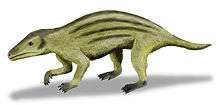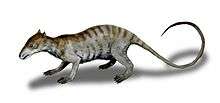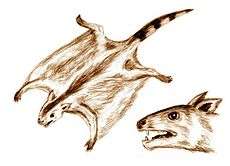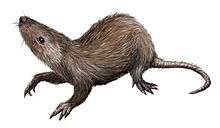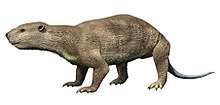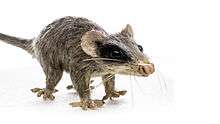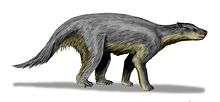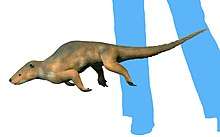Parectypodus
Parectypodus ("besides Ectypodus") is a genus of extinct mammal that lived from the Paleocene to the Eocene of North America. Some of the known fossil material may also be from the Upper Cretaceous. It was named by G.L. Jepsen in 1930.
| Parectypodus | |
|---|---|
| Scientific classification | |
| Kingdom: | Animalia |
| Phylum: | Chordata |
| Class: | Mammalia |
| Order: | †Multituberculata |
| Family: | †Neoplagiaulacidae |
| Genus: | †Parectypodus |
| Species | |
| |
It was a member of the extinct order of Multituberculata, and lies within the suborder of Cimolodonta, family Neoplagiaulacidae.
Species
- Parectypodus armstrongi (Johnston PA & Fox RC 1984)
- Place: Puercan (Paleocene) of Rav W-1, Saskatchewan, Canada. This specimen resides in the collection of the University of Alberta.
- Parectypodus foxi (Storer J.E. 1991). This Maastrichtian (Upper Cretaceous)-age species is estimated to have weighed about 80 g.
- Parectypodus laytoni (Jepsen G.L., 1940; Sloan R.E., 1966), also known as Ectypodus laytoni (Jepsen 1940). Remains are known from the Lower Tiffanian (Middle-Upper Paleocene) Princeton Quarry of Wyoming (United States). This species has been cited as a descendant of P. sinclairi. It is a small species, having a weight of perhaps 10 g.
- Parectypodus lunatus (Krause DW, 1982), also known as P. childei (Kühn, 1969).
- Place: Wasatchian (Lower Eocene) Pocket Quarry of Colorado and Wyoming. This is a late species, having a weight of about 35 g.
- Parectypodus simpsoni Jepsen, 1930. Eocene.
- Parectypodus sinclairi (Lamb 1902; Clemens 1964a)
- Parectypodus sloani (Schiebout J.A. 1974)
- Fossils of this species have been found in the Torrejonian (Paleocene)-age beds of Big Bend, Texas
- Parectypodus sylviae (Rigby J.K. 1980; Sloan 1987) (=Ectypodus aphronorus (Sloan 1987), P. pattersoni (Sloan 1987)). Remains are known from the Torrejonian (Paleocene)-age Swain Quarry of Montana and Wyoming. The body weight of this species has been estimated as 15 g.
- Parectypodus trovessartianus (Cope E.D. 1882; Van Valen & Sloan 1966)
- Place: Puercan-Torrejonian (Paleocene) San Juan Basin of New Mexico. The body mass of this species has been estimated to have been around 90 g.
- Parectypodus vanvaleni Sloan, 1981.
- Place: Puercan (Paleocene) San Juan Basin of New Mexico.
References
- Jepsen (1930), "New vertebrate fossils from the lower Eocene of the Bighorn Basin, Wyoming". Proc. Am. Phil. Soc. LXIX, p. 117-131.
- Jepsen (1940), "Paleocene faunas of the Polecat Bench formation, Park County, Wyoming". Pro. Amer. Philos. Soc 83, p. 217-340, 21 figs., 5 pls.
- Simpson (1935), "New Paleocene mammals from the Fort Union of Montana". Proc. US Nation. Museum 83, p. 221-244.
- Schiebout (1974), "Vertebrate paleontology and paleoecology of Paleocene Black Peaks Formation, Big Bend National Park, Texas". Texas Memorial Museum Bull 24: 1-87.
- Johnston and Fox (1984), "Paleocene and Late Cretaceous mammals from Saskatchewan, Canada". Paleontogr. Abt. A: Paläozool., Stratigr 186', p. 163-222.
- Kielan-Jaworowska Z. and Hurum J.H. (2001), "Phylogeny and Systematics of multituberculate mammals". Paleontology 44, p. 389-429.
This article is issued from Wikipedia. The text is licensed under Creative Commons - Attribution - Sharealike. Additional terms may apply for the media files.

